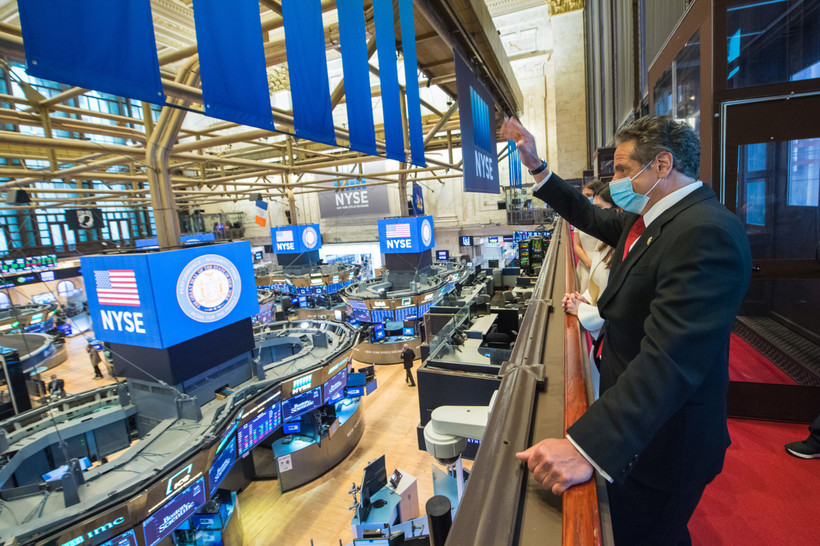New York Taxes Shoes and Soda. Why Not Stocks?
A stock transfer tax could bring in billions in new revenue. Wall Street threatens to pick up and leave—but tax experts say it’s probably bluffing.

This story was published in partnership with Gotham Gazette. Sign up for their newsletter here.
***
As the pandemic roiled stock markets in the spring, New York’s tax authority recorded surging revenue from an obscure tax on Wall Street stock trading. From April to June of this year, according to state tax department data, it collected $2.9 billion.
But the money never made it to state coffers: New York does not actually keep the tax revenue. Instead, since 1981, it has rebated the money to investors, meaning that, in practice, the stock transfer tax is little more than an administrative hurdle for brokers’ legal teams.
A proposal to start collecting the dormant tax has seen growing support in the state Legislature, following a staggering pandemic-spurred drop in tax revenue and state funding cuts to localities, which could deepen without an infusion of funds. The bill, which is one plank in a campaign led by progressive labor groups and activists, would end the rebate, allowing tax authorities to begin collecting the revenue again.
Opponents of the legislation center their argument on the threat of capital flight. If New York imposed the tax, they say, firms would move their residency or trading activities to another state to escape it.
“In the digital age it would be even easier for transactions to simply be moved out of state to avoid the tax,” Freeman Klopott, Cuomo’s budget spokesperson, said in a statement to New York Focus.
The reasoning echoes a recent memo circulated by lobbyists for the Securities Industry and Financial Markets Association (SIFMA), obtained by New York Focus, which argues that the tax would place heavy operational burdens on brokerage firms. “To avoid these additional costs, trading activity will naturally migrate to areas outside New York,” the memo reads.
But tax experts say that most frequently threatened avoidance strategies are unlikely to succeed.
Traders would struggle to evade the tax, even if they moved out of state, those experts say. The New York Stock Exchange is unlikely to pack up and leave, since it doesn’t pay the tax itself but passes it on to investors.
And investors are unlikely to stop trading on the exchange anytime soon, economists say, since New York’s trading hub far outstrips its closest rivals in high liquidity and low transactions costs—and would even after reinstituting a small tax on stock sales.
What transactions are in New York’s jurisdiction?
In order to impose a tax, the state needs “nexus”: it needs to show that the transaction occurred within New York’s jurisdiction.
But when most trading is electronic, what does nexus mean, anyway? The financial services industry is heavily concentrated in New York, but many operations—especially data storage and communication technologies—are housed in New Jersey and Illinois. Both of those states are currently seeing fierce pushback against similar efforts to impose a financial transaction tax.
Lawmakers seeking to tax finance say lobbyists’ arguments can seem like a game of whack-a-mole. Depending on which state is attempting to impose a tax, the securities industry may contend that what really confers tax jurisdiction is the location of trading firms, the location of exchanges, or the location of data centers. Failing those arguments, lobbyists argue that the industry is largely conducted beyond state borders, in the global financial cloud.
The stock transfer tax currently in place—the one that is immediately rebated—is levied on nearly all stock sales that occur “within New York State.” On paper, it imposes a tax of 1.25 cents on a sale of stock worth $5 or less a share, rising with the price of shares.
Under the bill to begin collecting that tax again, a transaction would be subject to the tax “if any activity in furtherance of the transaction occurs within the state or if a party involved in the transaction satisfies a nexus with New York state which shall be defined as broadly as is permitted under the United States Constitution.”
Could New York’s tax department really collect taxes under that ultra-broad definition?
The short answer, experts say, is: probably.
The United States has not seen a new financial transactions tax imposed in decades, meaning there is a lack of litigation on the issue—so it’s not clear which way courts would rule, if the STT were implemented and challenged. Even so, legal experts think a recent Supreme Court ruling means investors lack attractive options that put them beyond the long arm of New York’s tax authority.
What if trading firms moved out of state?
If a firm moved to New Jersey but continued trading on the New York Stock Exchange, New York would likely still have substantial enough connection to impose a tax, attorneys familiar with state residency requirements say.
Before the rise of online commerce, state tax authorities imposed sales tax on businesses with a brick-and-mortar presence in that state. In the 2018 decision South Dakota v. Wayfair, the Supreme Court relaxed the older “physical presence” requirement, noting that states are “confronting the complexities of defining physical presence in the Cyber Age.” Explaining that out-of-state tax exemptions had become “a judicially created tax shelter,” the Court expanded states’ ability to impose taxes remotely.
Timothy Noonan, a partner at Hodgson Russ LLC who specializes in litigation on tax residency in New York City and State, said Wayfair appears to give New York broad authority to tax trades that are requested in other parts of the country.
An investment firm seeking to avoid the tax might try to argue that it is unconstitutional for New York to tax an out-of-state firm, Noonan said. But the case would be hard to make.
“I think the government would point to the Wayfair case—point to the trend indicating that nexus, in 2020, is a lot easier to establish,” he said. “And that an economic presence, such as trading over the New York Stock Exchange, is enough to create that taxable nexus.”
The current trend, Noonan said, points toward more decisions like the one in Wayfair.
Darien Shanske, a tax professor at UC Davis Law School, told New York Focus that firms would probably not be able to escape the tax by leaving the state.
“If everything is the same, except that instead of yelling into your phone on the New York Stock Exchange [floor], you’re yelling into your phone in New Jersey—but all the other machinery is the same—then that still looks like New York has a good claim to tax that transaction,” he said.
Furthermore, Shanske said, New York’s tax department “is notorious for being persnickety.” The Department of Taxation and Finance has aggressively brought cases seeking to tax financiers who work from second homes in Connecticut or Vermont—and won them.
“The idea that the New York revenue authority is just going to be like, ‘Yeah, you moved to New Jersey, I guess we can’t tax you anymore’—that’s just not how it’s gonna go,” Shanske said.
Alternatively, an investor seeking to avoid the stock transfer tax might point out that trading is conducted through the New York Stock Exchange’s out-of-state servers.
But here, too, tax attorneys say it would be tricky to skirt New York’s jurisdiction. Since Wayfair, courts appear to care less about where sales transactions take place—whether in New Jersey, Panama, or cyberspace.
“Even if the servers are in the cloud,” Noonan told New York Focus, “if you follow the sales tax issue in the Wayfair case, an economic presence is enough to create that nexus. And the economic nexus here, the nexus of the transaction, would be, ‘We don’t care where the servers are, we don’t care where the traders are. It’s happening on the New York Stock Exchange. That gives us the nexus—the jurisdiction—to tax it.’”
What if the New York Stock Exchange left altogether?
What if the entire New York Stock Exchange relocated? (Many—though not all—of the equity purchases under the stock transfer tax are conducted on the NYSE.)
If the New York Stock Exchange moved to another state, Shanske said, this could pose a more serious threat to transfer tax collections, making it harder for the revenue authority to argue that NYSE’s stock trades remained within their tax nexus. Still, it would be a matter of degree.
“How much of the New York Stock Exchange has to move, or shift its business, before the connection is too slight? I’m not sure,” Shanske said. “It’s something of an unknown.”
Historians such as John Jay College’s Mike Wallace have cast doubt on the suggestion that the Exchange would pick up and move, pointing out that the NYSE threatened to move to New Jersey immediately after New York initially adopted the tax in 1905, but never followed through.
James Parrott, a tax policy expert and economist at The New School, said the battle is more a matter of political negotiation than about the marginal costs of algorithm-driven trading. If the stock tax is enacted without the acquiescence of industry, he said, brokers might retaliate.
“Whatever the relocation costs are involved in moving the New York Stock Exchange and NASDAQ and all of the trading floors out of New York,” Parrott said, firms might be prepared to pay “whatever it takes to evade this.”
To avoid this scenario, Parrott said, stock tax proponents should focus on building public pressure—so that a major undertaking like moving the stock exchange during a lopsided recession, to avoid a tax, would look too politically risky.
 New York Stock Exchange (Kevin Hutchinson)
New York Stock Exchange (Kevin Hutchinson)What if firms leave the New York Stock Exchange?
Another strategy the securities industry suggests might help investors skirt the tax: why not simply delist from the New York Stock Exchange, and conduct trades over cheaper platforms?
The trouble here, say economists who study stock trading, is that there are few good alternatives.
There’s the London Stock Exchange (LSE), but that floor has had an analogous transfer tax in place since 1694, despite continuous grumbling from traders. The LSE’s levy is frequently cited as a success story for transfer taxes, since it has not stopped the Exchange from consistently ranking among the world’s top exchanges by market capitalization.
Within the United States, economists who have studied stock levies say, investors in search of highly-liquid, low-cost trading platforms have few alternatives to the New York Stock Exchange.
“Even with the reinstatement of the STT, overall transaction costs for firms trading on the New York exchanges would almost definitely still be well below those of alternative trading platforms,” the economists Robert Pollin and James Heintz found.
“One of the advantages of the New York [Stock] Exchange is, with the high volume of trading, your transaction costs tend to be low. So, when you add in the stock transfer tax, it makes less of a difference,” said Schenectady Assemblymember Phil Steck, who sponsors the bill to revive the STT.
Stephany Griffith-Jones, an economist at Columbia University who studies financial markets, said moving off the New York Stock Exchange would carry other costs, like higher capital adequacy requirements—the amount of capital a financial institution is required to keep on hand—and increased legal risk.
Plus, she said, new markets do not spring up overnight.
“You’re going to want to sell in New York, because that’s where the big markets are,” Griffith-Jones said. “You’re not going to find, in Oklahoma, a lot of people wanting to trade very sophisticated securities.”
“A backdoor to federal relief”
Far from worrying that the stock tax would push firms to flee to other states, proponents tout the tax as a convenient way to capture new out-of-state revenue. Advocates contrast the STT’s potential to raise revenue from trades in New York and beyond with Cuomo’s escalating pleas for federal funding to replace lost tax revenue, which have so far failed to draw concessions from a gridlocked Congress.
Patrick Nelson, a Democratic Committeeman from Saratoga Springs, said the STT is one in a bundle of measures that could help New York capture a greater share of economic activity.
“We’re simply asking for some of the money back that we use, as New Yorkers, to bail out Kentucky and Mississippi and Florida and Texas and Georgia, and all these other states that take more from the federal government than they pay in,” said Nelson, who is the Democratic and Working Families Party nominee for State Senate in New York’s 43rd district. “It’s a means for us to access some of the money that we pay out to the other states.”
“You could almost think of it as a backdoor to that federal relief, as well,” Nelson added.
“Salami tactics”
Multilateral financial taxes—designed to span multiple states or governments—are more effective than unilateral ones, the International Monetary Fund (IMF) has found. Intuitively, this makes sense: scaled-up taxes offer fewer opportunities for escape.
Although local taxes are more vulnerable to evasion, several existing examples work fine. The same IMF study noted the success of the UK, Hong Kong, and Singapore in imposing STTs without international cooperation. “Unilateral STTs, even if levied on fairly narrow bases, are certainly feasible as witnessed by their use in numerous developed countries,” the study found—especially when imposed in “established financial centers.”
Local financial taxes can also be forerunners to national or international versions. In Europe, individual member states’ existing levies could soon be knitted together into a European Union-wide tax. Likewise, advocates for a state-level STT say it could be a forerunner to the national financial tax supported by senators such as Kirsten Gillibrand (D-NY).
Griffith-Jones, who has advised efforts to implement a European financial transaction tax, said the securities industry’s lobbying campaigns follow a predictable, divide-and-conquer pattern.
“It’s salami tactics,” she said. “They always do this. When the UK wanted to expand its financial transaction tax, even people on the right of the Labor Party would say, ‘Oh yes, we’ll do it, but only if the U.S. does it. For it to work, it has to be internationally coordinated.’”
While an international tax would be harder to evade than a national one, and a national tax would be harder to evade than a state tax, the question is just how much evasion would occur with a state tax. And many tax attorneys think that at the current level, most firms wouldn’t take on the hassle and cost of evasion.
“There’s clearly some level of stock transfer tax that is sufficiently low that nobody’s going to change their business structure to avoid it,” Shanske said. “And the rate on this tax is pretty low.”
Although debates have centered on the risk of tax flight, there are other considerations for and against reviving the tax. Opponents say it will cause job losses in the securities industry—which could have ripple effects—and that it will increase stock volatility. Proponents say it will reduce dangerous high-frequency trading by the same firms that have seen record profits amid coronavirus-driven market pandemonium. Still others say that it should be expanded beyond stocks to a broader tax on all financial transactions.
Michael Kink, director of the labor-backed progressive coalition Strong Economy for All, which is helping lead the push for several revenue-raising measures, said advocates would like to see more debate about tax initiatives outside annual hearings on the governor’s budget proposal. Typically, he said, there are too few occasions for on-the-record testimony by stakeholders.
“I would love public hearings as an opportunity to help lawmakers and the public understand the mechanics of all these bills.” Kink said. “Talking about proposals, digging into the details, forcing SIFMA to say in public under oath what they like to whisper and sleaze about in private.”
Hardly Urban Neo-Marxists
The stock transfer tax’s putative strength is its political feasibility: it is already on the books. Since the collection infrastructure is already in place, it has been popular among legislators looking for relatively painless ways to raise revenue without authorizing brand-new taxes. And unlike some other revenue-raising proposals being debated, it could immediately help fill state coffers devastated by the pandemic’s impact on existing taxes.
A federal financial tax has also gained popularity. Jared Bernstein, a top economic advisor to Democratic presidential nominee Joe Biden, is a vocal booster of the idea, as is Biden running mate Kamala Harris.
And even Michael Bloomberg, who shot down a proposal to reinstate New York’s STT as mayor, supported a federal equivalent during his 2020 presidential bid.
New York City Mayor Ed Koch supported reinstating the STT as part of an aid package to the city and the Metropolitan Transportation Authority, as the city struggled to close a $1.3 billion budget gap in 1982. Koch’s deputy mayor for finance, Kenneth Lipper—a Wall Street insider recruited from Salomon Brothers bank—reportedly opened discussions with brokerage houses about reinstating the tax.
“This is not a tax being proposed by left-wing radicals to pillage the coffers of the gentry,” New York Times columnist Sydney Schanberg wrote at the time. “Edward Koch and Kenneth Lipper hardly qualify as urban neo-Marxists.”
Yet the proposal to reinstate New York’s stock transfer tax has been stuck in the same news cycle for two decades: it is perpetually an idea whose time has finally come.
This past summer, as ebullient markets seemed to come unstuck from an underlying economy wracked by the COVID-19 recession, the business press once again reported that lawmakers were considering resurrecting the dormant tax. It’s a familiar pattern: proposals to bring back the STT have routinely surfaced during periods of fiscal strain, and then fizzled.
Now, momentum is building again for a spate of tax-the-rich proposals. Steck told New York Focus that his bill’s revenue-raising potential dwarfs alternatives.
“You’ll hear about the pied-à-terre tax, scaffolding tax,” Assemblymember Steck said. “You’re not going to get anywhere near those numbers.” Meanwhile, he adds, “the governor is an obstacle, because the governor is stuck in 1980.”
“We have this budget hole to plug, and the governor and the [Assembly] speaker [Carl Heastie] want to wait and see if Joe Biden becomes president,” Steck said. “If that happens, they may decide to go with some of the lesser revenue-raisers.”
But eyeing the upcoming legislative session in 2021, Steck is optimistic. With New York facing the most staggering fiscal hole since the 1970s, he said, “there might be no alternative.”
***
This story was published in partnership with Gotham Gazette. Sign up for their newsletter here.



